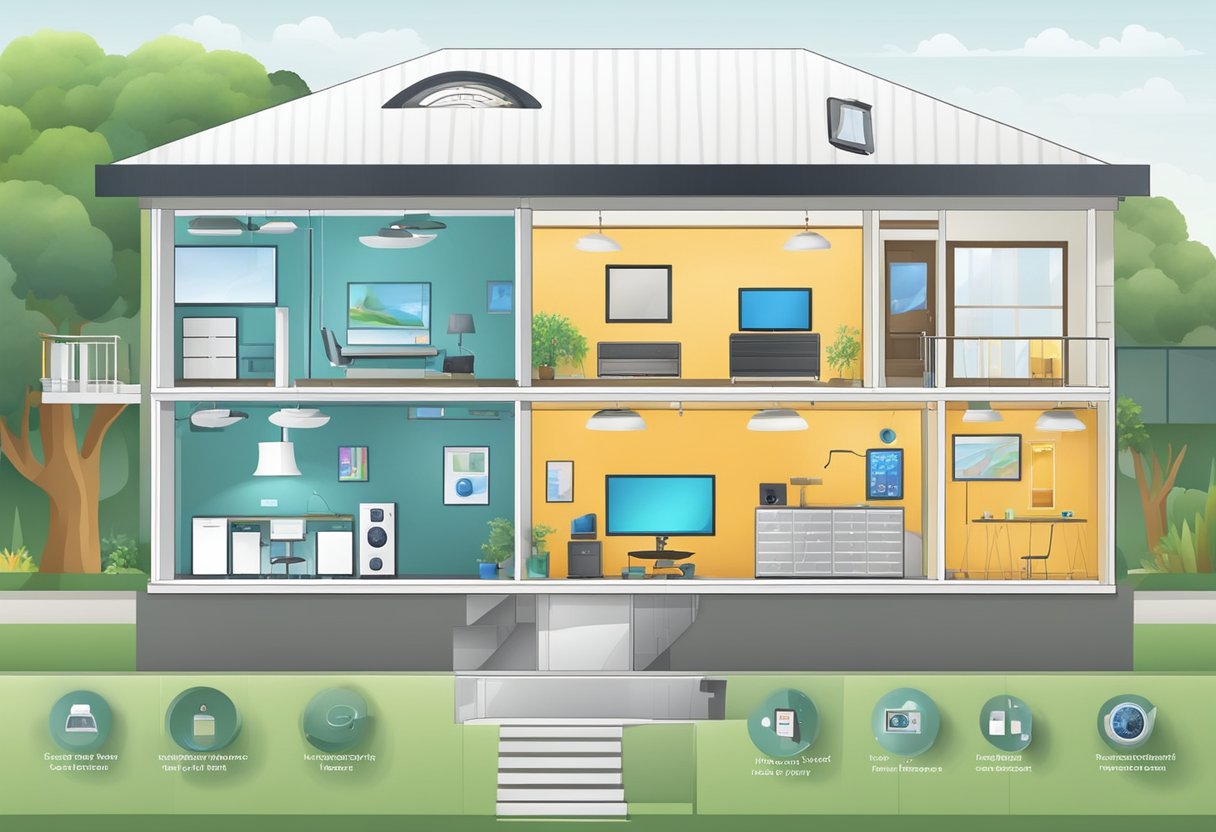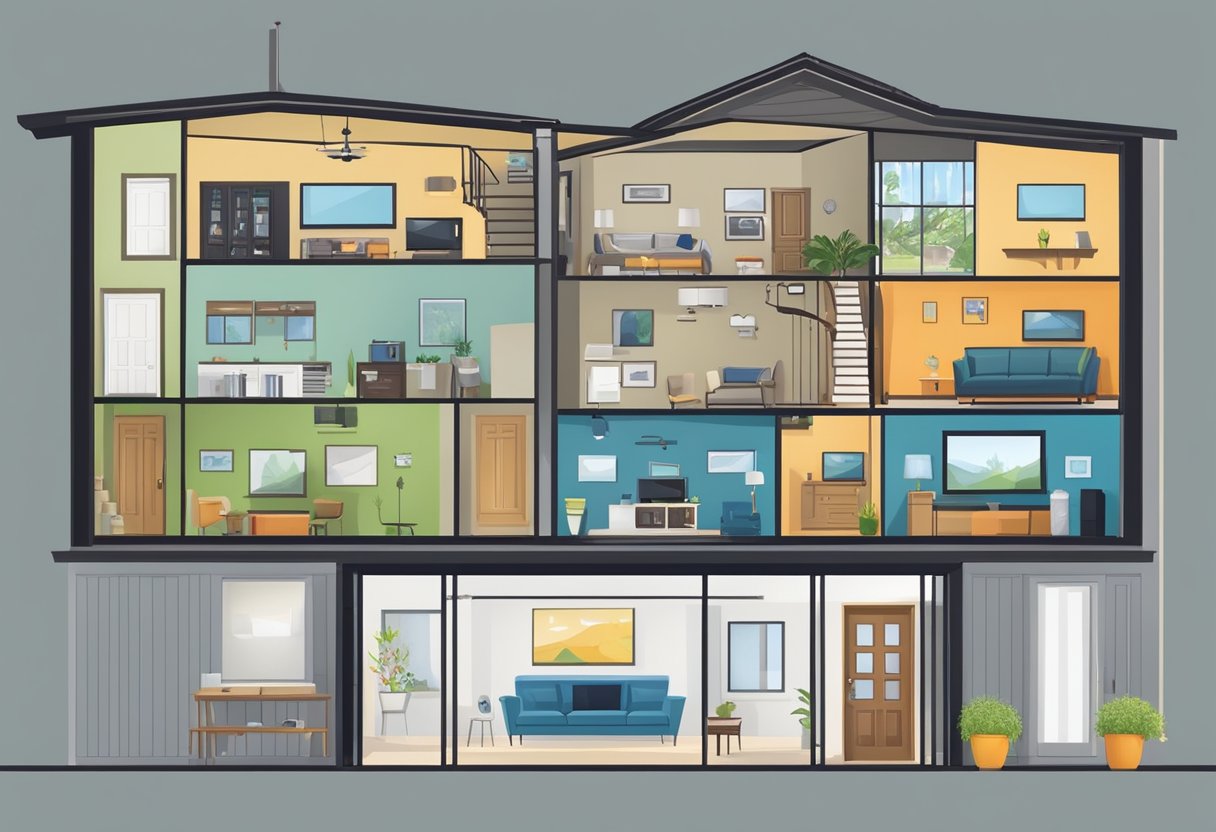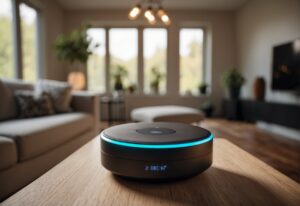Home security systems with a monitor are becoming increasingly popular as people look for ways to protect their homes and families. These systems offer a range of features, from basic door and window sensors to more advanced options like video surveillance and smart home integration.
Understanding Home Security Systems
Home security systems are designed to alert homeowners to potential threats and intrusions. They typically consist of a control panel, sensors, and an alarm.
The sensors are placed on doors and windows and are triggered when they detect movement or when the door or window is opened.
The control panel is the central hub of the system and is used to arm and disarm the system, as well as to receive alerts and notifications.
Monitoring Your Home Security System
One of the key features of a home security system with a monitor is the ability to monitor your home remotely.
This means that you can receive alerts and notifications on your smartphone or other device when the system is triggered.
Some systems also offer professional monitoring, where a team of experts will monitor your home 24/7 and alert the authorities if necessary.
Key Takeaways
- Home security systems with a monitor are becoming increasingly popular as people look for ways to protect their homes and families.
- Home security systems typically consist of a control panel, sensors, and an alarm, and can be monitored remotely or by a professional team.
- When choosing a home security system with a monitor, it’s important to consider factors like integration with smart home technology, installation and maintenance, and monitoring options.
Understanding Home Security Systems

Home security systems are an essential part of keeping your home safe from intruders. They are designed to detect and alert you to any unauthorized entry into your home, as well as provide you with peace of mind when you are away.
Components of a Home Security System
A typical home security system consists of several components, including sensors, equipment, cameras, motion sensors, sirens, and a base station.
The sensors are placed around the home to detect any movement, while the cameras are used to monitor the home from a remote location.
The motion detector is a device that detects any movement in the home and sends an alert to the base station.
The glass break sensors work by detecting the sound of breaking glass and alerting the base station.
The door lock is another important component of a home security system that can be controlled remotely.
Types of Home Security Systems
There are several types of home security systems available on the market today. The most common types include outdoor cameras, security cameras, and indoor cameras.
Outdoor cameras are designed to monitor the exterior of the home, while security cameras are used to monitor the interior.
Indoor cameras are typically used for surveillance purposes.
When choosing a home security system, it is important to consider your specific needs and budget.
A professional installation can be expensive, but it may provide you with better protection and peace of mind.
Alternatively, a DIY installation can be more affordable, but may not offer the same level of protection.
Monitoring Your Home Security System
When it comes to home security systems, monitoring is a crucial aspect that ensures the safety of your home and family.
There are two types of monitoring options available: professional and self-monitoring.
Professional vs. Self-Monitoring
Professional monitoring means that a team of trained professionals is monitoring your home security system 24/7.
They will receive an alert if the alarm is triggered and will contact you and emergency services if needed.
This option usually requires a monthly fee and may require a contract.
Self-monitoring means that you will receive the alerts if the alarm is triggered.
You will be responsible for contacting emergency services if needed.
This option usually does not require a monthly fee but may require a cellular backup for alerts.
Monitoring Plan Options
Most home security system providers offer different monitoring plan options.
These options may include 24/7 monitoring, cellular backup, and emergency services.
It is important to choose a plan that fits your needs and budget.
Some providers offer a subscription-based monitoring plan, while others offer a no-contract option.
It is important to read the fine print and understand the terms and conditions before signing up for a monitoring plan.
Integration with Smart Home Technology
Home security systems have come a long way in recent years with the integration of smart home technology.
Smart home technology allows homeowners to control their home automation and security systems from a single device or smartphone app.
This means that homeowners can monitor their homes from anywhere, at any time.
Smart Home Ecosystem Compatibility
One of the advantages of modern home security systems is their compatibility with smart home ecosystems such as Amazon Alexa, Apple HomeKit, Google Assistant, and others.
This means that homeowners can use voice commands to control their security systems, lights, and other smart home devices.
The integration with smart home ecosystems also enables users to receive alerts and notifications on their smart devices.
Home Automation and Security
Smart home technology also allows for greater control over home automation and security features.
Homeowners can set up automated routines that turn on lights, lock doors, and arm the security system when they leave the house.
They can also use third-party devices such as Arlo cameras, Z-Wave locks, and Zigbee sensors to enhance their home security.
In addition, smart home technology allows homeowners to integrate their security systems with other home automation features such as smart thermostats and entertainment systems.
This means that they can control the temperature, music, and other devices from a single app.
Choosing the Right Home Security System
When it comes to home security, choosing the right system can be overwhelming. There are many factors to consider, including the level of security needed, the budget, and the ease of use.
In this section, we will discuss the important factors to consider when choosing a home security system with a monitor.
Factors to Consider
Level of Security
The level of security needed will depend on the homeowner’s specific needs.
For example, a homeowner with valuable items may need a more robust system than someone who lives in a low-crime area.
Some systems offer video monitoring, while others only offer motion detection. It is important to consider the level of security needed when choosing a home security system.
Budget
Budget is another important factor to consider when choosing a home security system.
Professionally installed systems tend to be more expensive than DIY systems.
Some systems require a monthly subscription, while others do not. It is important to determine a budget and find a system that fits within that budget.
Ease of Use
The ease of use is another important factor to consider.
Some systems require professional installation, while others can be easily installed by the homeowner.
Some systems require a key fob or a code to arm and disarm the system, while others can be controlled through a smartphone app. It is important to choose a system that is easy to use and fits the homeowner’s lifestyle.
Comparing Top Security System Brands
When comparing top security system brands, it is important to consider the equipment packages, trial period, customer service, and add-ons available.
Ring
Ring is a popular brand that offers a variety of security systems, including video doorbells and professionally installed systems.
They offer affordable equipment packages and a trial period. However, some users have reported issues with customer service.
Cove
Cove is another popular brand that offers DIY systems with no contract.
They offer easy setup and a variety of add-ons, including glass break sensors and door locks. However, some users have reported issues with the equipment quality.
SimpliSafe
SimpliSafe is a well-known brand that offers both DIY and professionally installed systems.
They offer a variety of equipment packages and entry sensors. They also offer a self-monitored system with no contract. However, some users have reported issues with the monthly subscription and customer service.
Vivint
Vivint is a professionally installed system that offers a variety of equipment packages and video monitoring.
They offer a trial period and a variety of add-ons, including key fobs. However, some users have reported issues with the high cost and long-term contract.
ADT
ADT is a well-known brand that offers professionally installed systems with video monitoring.
They offer a variety of equipment packages and a trial period. However, some users have reported issues with the high cost and long-term contract.
Installation and Maintenance
When it comes to installing a home security system with monitoring, homeowners have two options: DIY or professional installation.
DIY vs. Professional Installation
DIY installation is typically less expensive and allows for greater flexibility in terms of where and how the system is installed. However, it requires some technical know-how and can be time-consuming.
Homeowners who opt for DIY installation should carefully read the instructions and watch any available video tutorials before getting started.
Professional installation, on the other hand, is more expensive but ensures that the system is installed correctly and functioning properly.
It’s also a good option for those who don’t have the time or inclination to install the system themselves. Many home security companies offer professional installation as part of their service packages.
Ongoing System Support
Once the system is installed, ongoing maintenance is necessary to ensure that it continues to function properly.
Homeowners should regularly check their system’s video storage and cloud storage to ensure that they have enough space for new recordings. If they don’t, they may need to upgrade their storage plan or delete old recordings.
Smart locks are also becoming increasingly popular as part of home security systems.
Homeowners should ensure that their smart lock is properly integrated with their security system and that it’s functioning correctly.
Frontpoint is one home security company that offers ongoing system support to its customers. Its support team can help homeowners troubleshoot any issues they’re experiencing with their system and can provide guidance on maintenance and upgrades.
It’s also important to review any contracts associated with the home security system.
Homeowners should ensure that they understand the terms of the contract, including any fees associated with early termination.
Finally, some home security systems offer facial recognition technology, which can help identify potential intruders.
Homeowners should ensure that this technology is properly configured and functioning correctly.
Frequently Asked Questions
What are the advantages of a wireless home security system with a monitor compared to a wired system?
Wireless home security systems with monitors offer the advantage of easy installation without the need for extensive wiring.
They also provide flexibility in camera placement and are often equipped with advanced features for remote monitoring and control.
How can I ensure my security camera with monitor setup is effective in deterring intruders?
To ensure an effective security camera with monitor setup, strategic camera placement is crucial.
Additionally, visible cameras act as a deterrent, while high-resolution video quality and motion detection capabilities enhance the system’s effectiveness.
What features should I look for in the best home security system with a monitor for remote viewing?
When selecting a home security system with a monitor for remote viewing, important features to consider include high-definition video quality, mobile app integration, cloud storage options, and the ability to receive real-time alerts and notifications.
How do security camera systems with monitor screens integrate with smart home technology?
Security camera systems with monitor screens can integrate with smart home technology through compatibility with voice assistants, smart home hubs, and other connected devices.
This integration allows for seamless control and monitoring of the security system within a smart home ecosystem.
What are the options for outdoor security cameras with monitors that do not require Wi-Fi?
For outdoor security cameras with monitors that do not require Wi-Fi, options include wired systems with a dedicated monitor or cellular-based cameras that transmit data over cellular networks.
These options provide reliable surveillance in areas with limited or no Wi-Fi coverage.
What should I consider when choosing a security camera with monitor and two-way audio capabilities?
When choosing a security camera with monitor and two-way audio capabilities, factors to consider include audio quality, noise cancellation features, and the ability to communicate with individuals near the camera.
Additionally, ensure that the camera has secure and encrypted communication for privacy and security.



